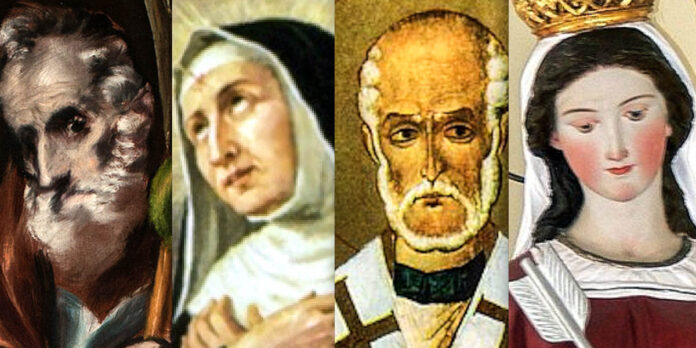Every person has instances of impossibilities in life. In these cases, we can seek the patronage of the patron saint of the specific impossible cause: St. Rita of Cascia, St. Jude Thaddeus, St. Philomena and St. Gregory of Neocaesarea. Read their life stories below.
Saint Rita of Cascia
St. Rita was born in 1381 in Roccaporena, Italy. Even though she had a difficult life she never let her difficulties destroy her faith. She had a deep desire to enter religious life; but her parents arranged her marriage to a cruel and unfaithful man at a young age. In obedience, St. Rita married him and prayed intensely for his soul. After almost twenty years of an unhappy marriage, he finally experienced a conversion, only to be murdered by an enemy soon after. Rita’s two sons became ill and died following their father’s death, leaving Rita without a family.
She wished again to enter the religious life. She sought permission to join the Augustinian convent repeatedly and they refused her, but finally she was accepted. Upon entry, Rita was asked to tend to a dead branch of the vine as an act of obedience. She watered the dry stick obediently, and it inexplicably sprouted and yielded grapes. The plant still grows at the convent, and its leaves are distributed to those seeking miraculous healing.
Soon after joining the convent, she became sick, and the sickness persisted until her death in 1457. She accepted everything with grace, and she believed that in her sufferings she was becoming one with Jesus.
Although her life was filled with seemingly impossible circumstances and reasons for despair, St. Rita never let her faith and her resolve to love God become weaker.
Saint Jude Thaddeus
Although St. Jude is perhaps the most popular patron of impossible causes, we don’t know much about his earthly life.
He was one of the Twelve Apostles of Jesus and he preached the Gospel with great passion, often in the most difficult circumstances. Tradition tells us that he was martyred for his faith while preaching to pagans in Persia.
He has become the patron of impossible causes through the Letter of Jude in the New Testament. In his letter, St. Jude urges Christians to persevere even in difficult times. Other saints—especially St. Bridget of Sweden—have also encouraged the Church to turn to St. Jude with great faith and confidence. In a vision, Christ told St. Bridget, “True to his surname, Thaddeus, the amiable or loving, he will show himself most willing to give help.” He is the patron of the impossible because Our Lord identified him as a saint ready and willing to assist us in our trials.
Saint Philomena
St. Philomena, the very name means “Daughter of Light,” is one of the many early virgin martyrs, women whom the Romans killed for their faith—as well as for their vows of chastity.
She died for her faith at the young age of 13 or 14. According to a few who have had visions of her short life, Philomena was of noble birth to Christian parents, and she dedicated her virginity to Christ. When she refused to marry Emperor Diocletian, she was cruelly tortured in many ways for over a month. She was scourged, thrown into a river with an anchor around her neck, and shot through with arrows. Miraculously surviving all these attempts on her life, she was finally beheaded. Despite the tortures, she did not waver in her love for Christ and her vow to Him.
Many miracles have happened through the intercession of this saint. Hence she came to be known as “The Wonder Worker.”
Saint Gregory Thaumaturgus
St. Gregory of Neocaesarea, also known as St. Gregory Thaumaturgus (“the Wonderworker”), was born in Asia Minor around the year 213.
Although he was raised as a pagan, at age 14 he was deeply influenced by a good teacher, and thus was converted to Christianity together with his brother. He became a bishop in Caesarea in his 40s, and served the Church in this role until his death 30 years later. Many people were converted to Christianity inspired by his preaching and life.
According to St. Basil the Great, St. Gregory Thaumaturgus is comparable to Moses, the prophets, and the Twelve Apostles. St. Gregory of Nyssa says that Gregory Thaumaturgus experienced a vision of Our Lady, one of the first such recorded visions.
These four saints are known especially for their prowess in interceding for impossible, hopeless, and lost causes.



